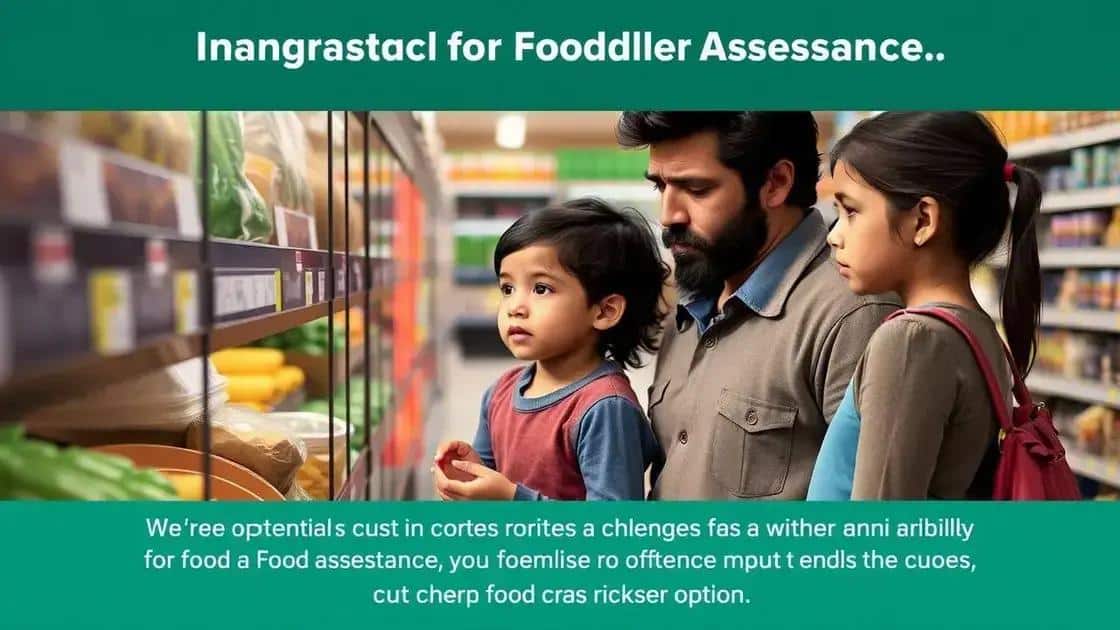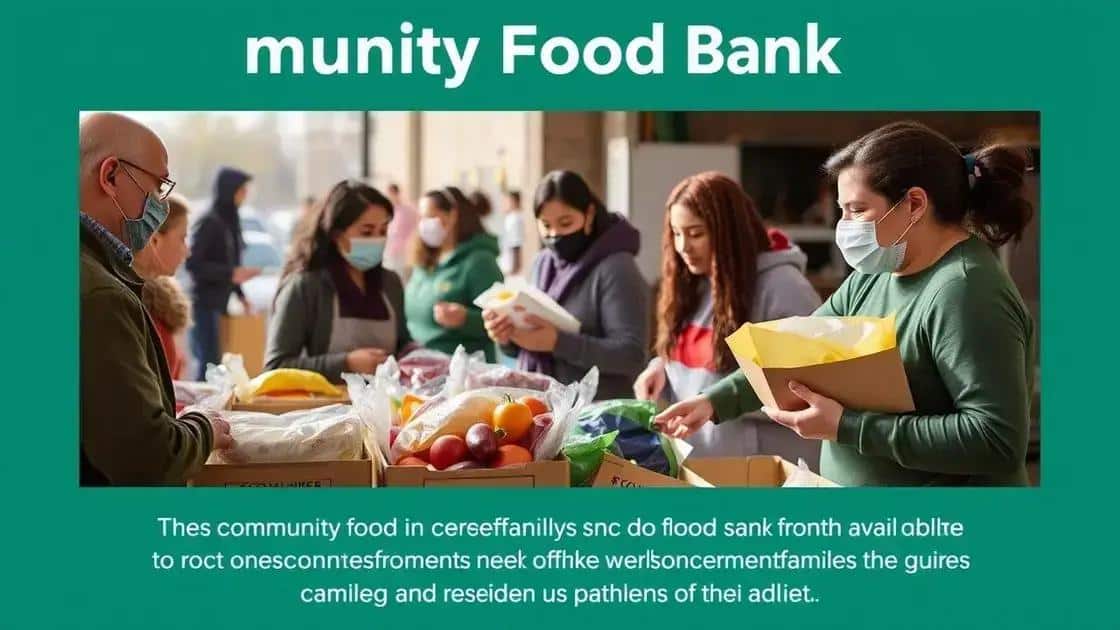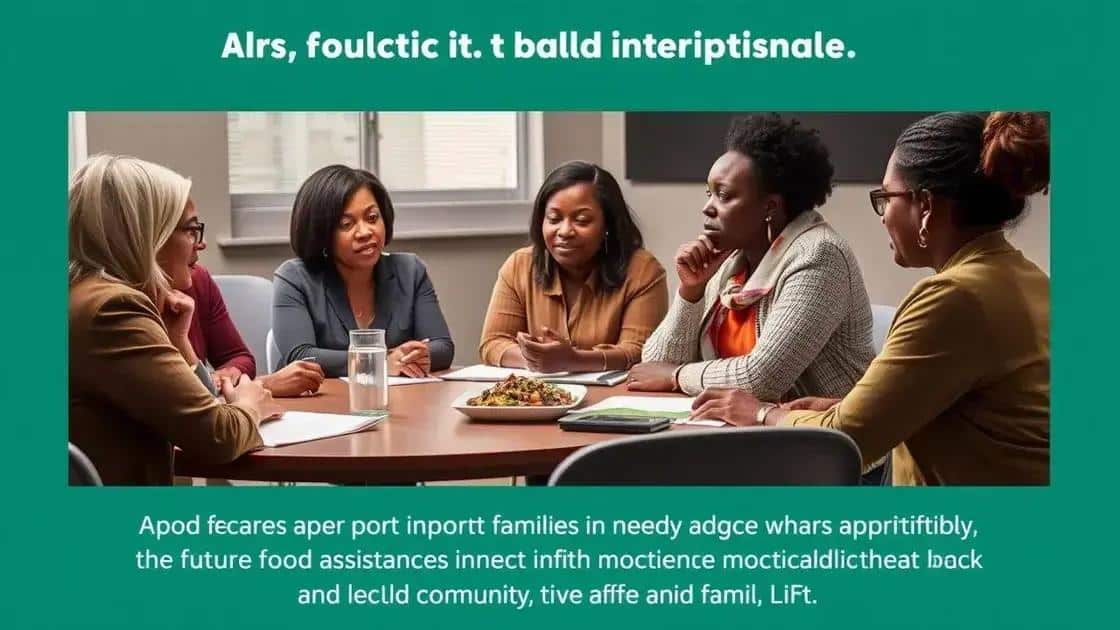People in Illinois worried about food assistance cuts
Anúncios
People in Illinois are worried about potential cuts to food assistance in the SNAP program, which could significantly impact families’ food security and access to essential resources.
People in Illinois worried about food assistance being cut in a SNAP program are feeling anxious about how this might affect their daily lives. Are these concerns valid, and what could this mean for families across the state?
Current SNAP status in Illinois
The Current SNAP status in Illinois reflects significant changes that could affect many families. Understanding these changes helps residents prepare for the future and advocate for their needs.
Recent Developments
In 2023, several modifications in the SNAP program were proposed. These changes focused on funding and eligibility criteria, bringing some concern among recipients. As more families rely on this assistance, the potential to alter benefits raises questions.
Key Points to Consider
-
⚖️ Eligibility limits have shifted, impacting who qualifies.
-
💸 Funding cuts could lead to fewer resources for families.
-
📉 The state has seen a rise in unemployment, increasing reliance on SNAP.
-
🥫 Local food banks also report higher demands for assistance.
Families across Illinois are feeling the pinch, especially those who depend on SNAP for groceries. The discussions surrounding these changes create a sense of urgency among community leaders and government officials.
With more families needing help, it’s crucial to follow updates on SNAP. Many are involved in initiatives advocating for fair food assistance, which highlights the fight to maintain vital resources. Understanding changes in SNAP not only equips individuals with knowledge but also empowers communities to support one another.
Implications of potential cuts

The implications of potential cuts to SNAP in Illinois can be severe for many families relying on this crucial assistance. Understanding these effects helps communities grasp the full impact of any decisions made regarding food aid.
Direct Effects on Families
Cutting SNAP benefits could mean fewer groceries for families, leaving many struggling to put food on the table. As food prices rise, this becomes even more concerning.
Economic Impact
Besides affecting individual households, potential cuts to SNAP also harm the local economy. Fewer benefits lead to decreased spending at grocery stores. This not only hurts families but also impacts local businesses that rely on SNAP participants to support their sales.
- Loss of crucial funds could decrease food security.
- Local stores may experience lower revenue.
- Charitable organizations might see an uptick in demand.
- Increased reliance on food banks could strain their resources.
For many residents, SNAP serves as a lifeline, ensuring they have adequate nutrition. Cuts could force them to make difficult choices, compromising their health and well-being. A further consequence of these cuts may be the pressure placed on non-profits to fill the gap left behind.
Community leaders and advocates are raising the alarm about what these potential cuts could mean. It is essential to keep these dialogues active and ensure residents are aware of the options available to them, even in challenging times. Together, communities can work to make their voices heard and support each other through these difficulties.
Voices from affected families
The voices from affected families provide crucial insights into the real impact of potential SNAP cuts. These stories highlight the daily struggles and the ongoing fear related to food insecurity.
Real-life Experiences
Many families depend on SNAP to provide healthy meals. For them, losing these benefits could mean making heartbreaking choices. Imagine a parent having to decide between paying rent and buying groceries. These tough decisions are becoming more common.
Personal Testimonies
- A mother of three shares how SNAP keeps her family nourished, stating, “Without it, we would be lost. Food prices are too high.”
- A father explains the stress he feels, saying, “I’m constantly worried about how to provide for my kids. The thought of losing SNAP makes it worse.”
- A single grandmother voices, “I rely on SNAP. If cuts happen, I fear I won’t have enough for my grandchildren.”
These voices reveal the urgent need for continued support. Families across Illinois are more than just numbers; they are individuals with unique stories. As they navigate life’s challenges, their experiences emphasize that community support and understanding are more important than ever.
Creating awareness around these stories can drive the conversation forward. Advocacy groups bring together these voices to ensure that policy makers recognize the human side of such decisions. When families speak out, they shine a light on the critical importance of food assistance and its role in their lives.
Alternatives for food assistance

With potential cuts to SNAP, exploring alternatives for food assistance becomes essential for families. Many options exist to help those in need maintain access to food and resources.
Community Food Banks
Food banks play a crucial role in providing immediate support. They are often locally based and can supply families with nutritious food options. Many food banks also offer additional services, such as nutrition education and cooking classes.
Local Meal Programs
Programs designed to provide meals directly to families are enhancing food security. These initiatives often target children, seniors, and low-income households, ensuring they receive both meals and the nutrition they require.
-
🍽️ School meal programs offer free or reduced-cost breakfast and lunch.
-
🧑🦳 Seniors can access meal delivery services to help them stay nourished.
-
🍲 Community kitchens may provide cooked meals at little to no cost.
Besides food banks and meal programs, local organizations often provide resources such as grocery vouchers or assistance in applying for SNAP. These programs ensure that families do not need to stretch their budgets beyond breaking point.
Obtaining fresh produce is also possible through community gardens or farmers’ markets that accept EBT (Electronic Benefits Transfer). These initiatives not only support personal nutrition but also strengthen local economies.
In times of crisis, these alternatives provide a safety net for families facing food insecurity. By tapping into available resources, individuals can find help and support during challenging times. It’s vital to connect families to these resources, helping them thrive within their communities.
Community support initiatives
Community support initiatives play a vital role in helping families facing food insecurity, especially in times of potential SNAP cuts. These initiatives create a network of support within neighborhoods, ensuring that no one is left to struggle alone.
Programs and Services
Various community-driven programs are available to assist those in need. Many local churches and non-profit organizations offer food distribution days where families can receive groceries without barriers. This direct help is often crucial for families who may feel hesitant to ask for assistance.
-
🍲 Community kitchens provide meals to those who cannot afford them.
-
🏠 Local shelters often offer food pantries as part of their services.
-
🛍️ Neighborhood associations may organize food drives to collect donations.
-
🤝 Volunteer programs allow citizens to contribute by helping to package and distribute food.
Another impactful initiative is the development of community gardens. These gardens enable families to grow their own produce, significantly enhancing food security. Moreover, they promote healthy eating habits by providing fresh fruits and vegetables.
The sense of community grows stronger through these initiatives as they not only provide nutritious food but also foster connections among residents. Programs often include workshops that teach cooking skills and nutrition education, which empower families to make healthier choices.
Active participation from community members leads to greater awareness and support for those in need, reminding everyone that they are not alone. Building these local support systems is essential, especially as challenges grow for families relying on SNAP and other assistance programs.
Future outlook on food aid

The future outlook on food aid is a pressing concern as policymakers assess the needs of communities. Understanding how food assistance programs may evolve is essential for families relying on them.
Upcoming Changes
Future decisions regarding SNAP and other food programs will likely focus on sustainability and support for low-income families. Legislators are discussing potential reforms that aim to increase benefits and expand access. This means that more families may qualify for assistance in the coming years.
Impact of Community Advocacy
Community advocates are becoming increasingly active in discussions surrounding food aid. Their voices can influence policy decisions, pushing for changes that better serve those in need. Advocacy efforts help to raise awareness about hunger in Illinois and the importance of continuing strong food assistance programs.
- Increased funding for food programs is a major goal.
- Expansion of eligibility could allow more families to receive assistance.
- Support for local food systems is gaining recognition as critical.
- Collaboration between organizations can enhance distribution and impact.
Experts predict that the combination of community involvement and governmental support will result in a more robust and resilient food aid system. By fostering these connections, communities can create a network that not only addresses immediate needs but also builds long-term solutions.
Children and families will benefit greatly from enhanced food assistance programs. Research shows that stable access to healthy food improves overall well-being and educational outcomes. This gives added urgency to the conversation about the future of food aid.
The future of food assistance in Illinois is crucial for families who depend on these resources. As we have explored, community initiatives, advocacy efforts, and an awareness of the changing landscape can create a stronger support system. Ensuring that everyone has access to food is not just a necessity but a shared responsibility. By working together, we can help make food aid more robust and effective, ultimately leading to healthier, happier communities.
FAQ – Frequently Asked Questions about Food Assistance in Illinois
What is SNAP, and who qualifies for it?
SNAP, or the Supplemental Nutrition Assistance Program, provides food assistance to low-income individuals and families. Eligibility depends on household income, expenses, and size.
How can I find local food banks or meal programs?
You can find local food banks or meal programs by checking websites like Feeding America or using community resources like libraries and churches for information.
What alternatives exist if SNAP benefits are cut?
If SNAP benefits are cut, alternatives include community food banks, local meal programs, government food assistance vouchers, and community gardening initiatives.
How can I get involved in community food assistance programs?
You can get involved by volunteering at local food banks, participating in food drives, or engaging with community organizations that focus on food security.






